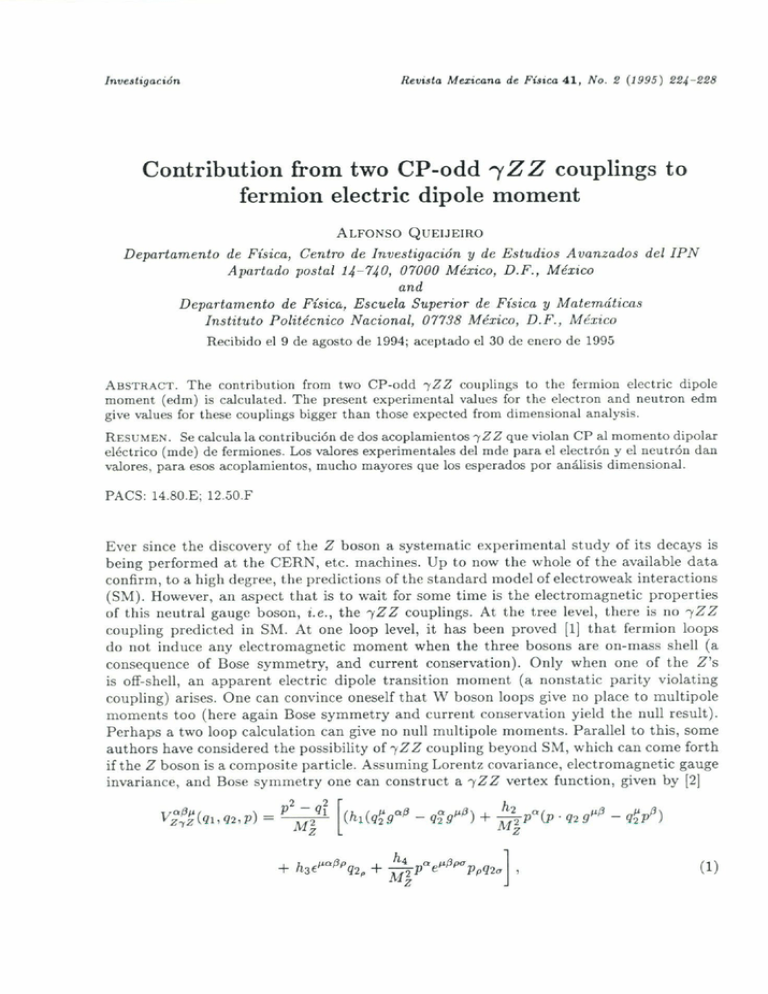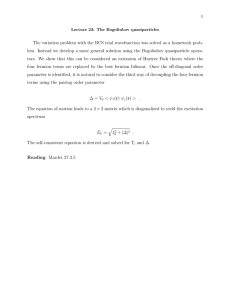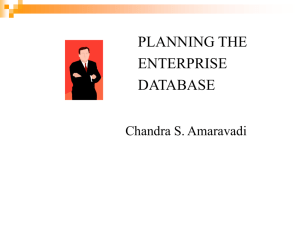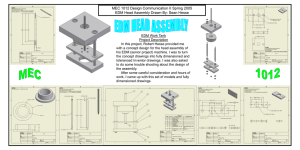Contribution from two CP-odd , Z Z eouplings to fermion electrie
advertisement

Revüta lnve"tigación Mexicana de Fúica 41, No. 2 (1995) 224-228 Contribution from two CP-odd , Z Z eouplings to fermion electrie dipole moment ALFONSO QUEIJEIRO Departamento de Física, Centro de Investigación y de Estudios Avanzados del IPN Apartado postal 14-740, 07000 México, D.F., México and Departamento de Físieú, Escuela Superior de Física y Matemáticas Instituto Politécnico Nacional, 07738 México, D.F., México Recibido el 9 de agosto de 1994; aceptado el 30 de enero de 1995 ABSTRACT. The contribution [rom two CP-odd -yZZ couplings to the [ermion e¡ectric dipole moment (edm) is ealeulated. The present experimental values for the eleetron and nentron edm give values for these couplings bigger than those expeeted from dimensional analysis. RESUMEN. Se calcula la contribución de dos acoplamientos ...,.ZZ que violan CP al momento d¡polar eléctrico (mde) de [ermiones. Los valores experimentales del mde para el electrón y el neutrón dan valores, para esos acoplamientos, mucho mayores que los esperados por análisis dimensional. rACS: 14.80.E; 12.50.F Ever since the discovery of the Z boson a systematic experimental study of its decays is being performed at the CERN, etc. machines. Up to now the whole of the available data confirm, to a high degree, the predictions of the standard model of electroweak interactions (S1\1). However, an aspect that is to wait for sorne time is the electromagnetic properties of this neutral gauge boson, i.e., the -yZZ couplings. At the tree level, there is no -yZZ coupling predicted in 51\1. At one loop level, it has been proved [11 that fermion loops do not induce any electromagnetic moment when the three bosons are on-mass shell (a consequence of Bose symmetry, and current conservation). Only when one of the Z's is off-shell, an apparent electric dipole transition moment (a nonstatic parity violating coupling) arises. One can convince oneself that \V boson Joops give no place to multipole moments too (here again Bose symmetry and current conservation yield the null result). Perhaps a two loop calculation can give no null multipole moments. Parallel to this, sorne authors have considered the possibility of -y Z Z coupling beyond 51\1, which can come forth if the Z boson is a composite particle. Assuming Lorentz covariance, electromagnetic gauge invariance, and Bose symmetry one can construct a -y Z Z vertex function, given by 121 0/3 Vz,i(q¡,q2,p) = p2 - q[ [ M2 (hl(q~gO z /3 -q2g~ h2 )+ M2pO(p.q29~ /3 z /3_6 -q~v) (1) CONTRIBUTION FROM TWO CP-ODD P,) FIGURE 1. The,Z Z anomalous coup1ing "IZZ COUPLINGS... 225 (P.) conlribution to the ferrnioo edm. where, as indicated, q¡", q2~ and PI' are the 4-momenta of the Z, "1 and Z respectively. Note that when both Z bosons are on-shel!, the vertex function vanishes. Al! of the hi form factors are C-odd. Then hJ and h4 are CP-even, while h¡ and h2 are CP-odd. The four hi can be restricted by sorne physical observable. For instance, hJ and h4 could contribute to the rnuon anomalous magnetic rnoment, however it has been shown [31 that none of them contribute to (9 - 2)1" The other two, h¡ and h2, can contribute to fermion electric dipole mornent (edrn). The result of this calculation is reported in this papero Here 1 have considered the vertex function (1) with one of the Z bosons on-shel!, and assumed the 51\1coupling for fermionZZ. The contribution to the ferrnion edm is depicted in Fig. 1, and the corresponding amplitude is given by (2) where M" = J (~:~4 2+)"1", (a + !rys) (k + V iD"", (k - V V;;: (k - ~, q, k + V ¡¡(PI), ii(P2hiJ' x iDiJW (a + !ryS)iSF (-k +P and SF( -k + p+/2), D",,' (k:!:: ~) are the propagators of the ferrnion loop, respectively. ¡¡(p) is fermion wave function, and the fermion-Z written in terms of the parameters a = + and b = Q f sin2 Ow, TJ R,L being the weak isospin third component of the function Vz, z is explicitly given by 9k 9L 9k - 9L (3) and Z bosons in the has been with = TJ fermion. The vertex Z coupling 9k,L R,L - 226 ALFONSO The evaluation to edm, QUEIJEIRO of Eq. (3) is quite standard, with the result, for the terms contributing (5) The functions Jn are defined by Jn = J d'k kn (271" )' -( k-.2---¡-(-x-, y-) )-2 ; m being fermion mass. To regularize the divergent integrals in Eq. (5) a cutoff /1. is introduced. As has been pointed out by Burgess and London [41 the contributions /1.2 and /l.' can be ignored, since they are to be cancelled by contributions generated by sorne high energy part of the theory. Then, only the logarithmic dependence on /1. is significative. (An equivalent procedure is to modify the Z-boson propagator thraugh a form factor, which renders finite the divergent integral up to the leading logarithmic contribution for /1.2 » MJ:). With this in mind, the fermion edm fram Eq. (5) turn out to be dr = e _0__ ma_b 32rr MJ: 1 sin2 Ow cos2 For an electran a = -1 Idel The experimental [h 0w + 4 sin2 2 2 ¡ (2 _ ~ In _/1._) 3 MJ: _ h2 (1 _ 71n _/1._)] ~ 48 . MJ: (6) 0w and b = -1. Using /1.~ 1 TeV, Eq. (6) gives = 12.54 x h¡ + 4.27 x h21 x 10-26 (ecm). (7) value [51 of de de = (-0.3:l: 0.8) x 10-26 (ecm). imposes the constraints IhJi = 0.34 if h2 =O Ih21 = 0.20, if h¡ = O. and For muo n the experimental result gives a poorer constraint (8) on h¡ and h2. CONTRIBUTION FROM TWO CP-ODD "(Z Z COUPLlNGS. •. 227 To evaluate neutron edm from Eq. (6) the method in Ref. [6] is followed. This gives, at the quark level dq = 3.3. x 10 where mn is neutron -22 mnob (1 GeV)(O.4h¡ (9) (ecm), mass. Then, using the SU(6) result dn = ~da - idn, it is obtained Idnl = 2.56 x 1O-2210.4h¡ and the experimental +0.6h2) bound [5lldnl + 0.6h2 1 (ecm), < 11 x 10-26 (ecm) imposes the constraints and (10) which are more stringent bounds. In getting the aboye results we have assumed no cancel!ation among the h¡ and h2 contribution. In a real situation both contribution can be present, simultaneously, and then they couId cancel each other if h¡ and h2 turo out to be of the same arder of magnitude. This could be the case for the constrains in Eq. (8), which are not good. Equation (10), a more realistic h¡ and h2 constrains, tel! us that there is a difference of one arder of magnitude between them. That Eq. (10) gives more realistic bounds can be seen as fol!ows. Since h¡/m1 is the coefficient of a dimension-6 operator it is expected to be of arder 10-4, for A = 1 TeV. Similarly, since h2/ M~ is the coefficient of a dimension-8 operator, h2 has to be of arder 10-6. In the light of this, the bounds (8) and (10) are bigger than the values expected from dimensional analysis. Perhaps good contraints for h¡ and h2, consistent with dimensional analysis, can be extracted from unitarity arguments. ACKNO\VLEDGMENTS The author wishes to thank Roberto Martínez for interesting discussions on the subject. He 'lIso acknowledgcs partial support from Comisión de Operación y Fomento de las Actividades Académicas del IPN-México. REFERENCEs 1. A. Barroso, F. Boudjema, J. Cale and N. Dombey, Z. Phys. e - Portie/es and Fields 28 (1985) 149. 2. Sce, for example, K. Hagiwara, R. Pcccei, D. Zappenfcld alld K. Hikasa, Nue/. Phys. B 282 (1987) 253. 228 3. 4. 5. 6. ALFONSO QUEIJEIRO D. Méry, S.E. Mounbarik, M. Perrottet and F.M. Renard, Z. Phys. 46 (1990) 229. C.P. Burgess and David London, Phys. Rev. Lett. 24 (1992) 3428. Partide Data Group, Phys. Rev. D50 (1994) 1173. \V.J. Marciano and A. Queijeiro, Phys. Rev. D33 (1986) 3449. e - Partides and Fields



